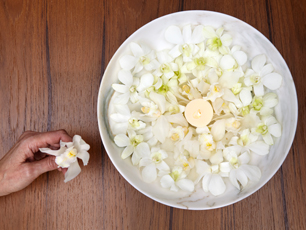- Tweet
-
CALL: (415) 431-3717 Hours: 9AM-5PM PST. EMAIL: WECARE@SEVENPONDS.COM
After Death Planning Guide
4 Remembrance Event
- Overview
- 1 Immediate Help
- 2 Choosing Disposition
- 3 Settling Estate
- 4 Remembrance Event
- 1. Seeking Assistance in Planning
- 2. Types of Services and Remembrance Events
- 3. Memorial Donations
- 4. Event Invitations
- 5. Location Options and Considerations
- 6. Other Details to Consider
- 7. Personalizing the Event
- 5 Healing Process
- 6 Checklist
- Acknowledgements

Remembrance Event: What Do I Do When Someone Dies?
There is a definite comfort in coming together with others to remember someone. People are increasingly planning personalized, creative events at locations that hold special meaning. Events can reflect spiritual beliefs and can be tailored to suit the sensibilities of both the person who has passed and family and friends. Truly, the possibilities for a meaningful remembrance event are endless.
For many people, planning a special remembrance event or memorial service for their loved one is an important step in celebrating the person’s memory. Here, we present a sampling of options and considerations for the contemporary person who is looking for something other than the traditional funeral service.
1. Seeking Assistance in Planning
Planning a remembrance event can be heartfelt and truly unique experience, but it can also be a daunting task. If you do not want to hire a professional, you can ask friends or family members to help. Take note on your After Death Checklist of who has agreed to help and what aspect of planning they will be responsible for.
Alternatively, you can hire an event planner to lead the preparations and implementation of a remembrance event. Event planners typically assist with things like guest list management, location considerations, catering, and servicing. Or you may want to hire a celebrant, who can officiate and also help think up meaningful ways to personalize your ceremony. See Officiants & Celebrants on our Local Resources page.
Budget
If your loved one has left a will or trust, or set up a payable upon death account, there may be money set aside for a remembrance event. If there is not, it is a good idea to set up a budget in advance of planning.
2. Types of Services and Remembrance Events
Type of Service
First and foremost, decide what kind of event—and also how many events—you wish to have. Each type will have its own challenges and rewards. For example, you might want to have a meal at one location, and move to another for an ash scattering. If plan on scattering the ashes, you have the option to wait to hold the ash scattering for many months, until everyone is able to assemble at a special location. You may opt for a small event restricted to family members, a larger event for everyone who knew the person who passed, or both.
Memorial Service or Life Celebration
You may choose to have a simple memorial service, where a small number of people gather to say a few words. Or, you might prefer to have a grand celebration, like a party with dancing and activities. This event can be held immediately after the death, or you can wait several weeks, months, or even a year. It can be held anywhere from a private residence to a mountaintop. If you choose, you can make it into a weekend event or a destination location, allowing family more time to grieve and bond over the loss. Consider what is special to the person who died, or to you and your family, when planning this memorial event.
Ash Scattering
Following a cremation, you may wish to hold an ash scattering ceremony. When planning this event you’ll want to consider the method of scattering, the location, and who and how many people will scatter the ashes.
Scatterings can take place on land, lake, or sea. You can also opt for a more unique scattering method, such as via hot air balloon, plane, or even a rocket. If desired, you can hire someone to take the ashes to a special, remote location to scatter. Note that some areas have laws regarding ash scattering, so you’ll want to keep this in mind when planning. See Cremation Scattering Services in our Local Resources section.
At the ceremony, it is common for one person to physically scatter the ashes, but if you’d like the ashes can also be divided and distributed among family members and friends to scatter together.
A wide variety of vendors offer urns or cremation vessels to scatter ashes from; see Cremation and Burial Products in Local Resources for some lovely options.
Home Funeral
A home funeral is a celebration in the home with the person who passed present. This requires the natural death care process and typically includes hiring a home funeral consultant to aid you in keeping the body at home. Look for Home Funeral Consultants in our Local Resources section.
It is possible to perform natural death care without a consultant, however you will need to plan and prepare for this in advance of a death. In this case, you will definitely need assistance from family and friends. Follow our step-by-step instructions here.
With a home funeral comes the comfort of being in the home, and the time it allows you to say goodbye. As you plan, consider the location of the body in the house, and how people will say their goodbyes. You can lay him or her on a bed, on a couch, or even outdoors in grass or in a garden. Perhaps you’ll dress him or her in special clothing, or place personal items with them. Also, if you wish, think about purchasing a beautiful cloth shroud or a simple wooden casket. You may want to use a cardboard container, which is easy to custom decorate. For more options see Cremation and Burial Products in our Local Resources section.
Graveside Service
First, consider where the burial will take place. You might want to bury your loved one on rural, private land; check local laws regarding private burial. Alternatively, most natural burial grounds or green cemeteries allow the family to be involved in the burial process.
For a natural burial, also called green burial, you will need a shroud, a simple casket, or a cardboard container. You’ll want to identify which friends and relatives can help conduct the necessary tasks, such as pall bearing, closing or scattering earth over the grave, or reciting a saying. You might want to conduct a full service at the graveside with the help of an officiant, or you might want to have a string of events in different locations; your graveside service may follow a home funeral or an event dinner. There are a variety of ways to incorporate a graveside service into your remembrance event, so feel free to be creative in your planning.
Wake
You may wish to have a wake at the home of a family member or at an outside venue. It can be that simply gathering together for a meal is your way of honoring your loved one. Or, the meal can be part of a series of events. It’s completely up to you.
Other Options
There are countless ways to commemorate life and death, and today you can be as creative as your ideas allow. From open-air funeral pyres in Colorado to memorial reefs in costal states, unique options are becoming available. Remember, although legal considerations will limit some choices, it is ultimately your decision how you remember and celebrate the life of your loved one.

3. Memorial Donations
Think about what you want the guests to bring to a memorial event. While flowers are a lovely gift, you might consider requesting that guests make a memorial donation in lieu of flowers, perhaps to the charity of choice for you or your loved one. This request can be made through written letter or email prior to the event, or in the invitation itself. People can indicate in whose name the donation is being made. The family can then receive a notification following the donation.
4. Event Invitations
Make a List of Potential Attendees
This list will depend on your budget, timing, and what type or how many events you plan to have. Besides family and close friends, you might consider inviting your loved one’s peers, co-workers, or members of groups he or she belonged to, such as a book club or a sports team. It is best to develop this list early on so you can get a good idea of the number of guests you’ll want to invite.
Preparing Invitations
There are many websites where you can custom-make online invitations, such as Paperless Post and Punchbowl. Other websites allow you to order hard copies, like Minted and TinyPrints. You can also hire a professional to draft them, or ask an event planner to help you select them. However if you have a manageable number of attendees, you might consider just making personal phone calls rather than sending out invitations.
Information to Include on Your Invitations
- Name of person who passed.
- Date, time, and place of death.
- Date, time, and location of event or ceremony.
- Type of ceremony.
- Gift or item you may wish attendees to bring: this can be a photo, a personal memento, something to say, or flowers.
- Food and refreshment options, if you choose.
- Your reasons for the ceremony: for some events and locations, particularly unusual ones, it might be helpful to include an explanatory note as to the significance. For example, for an ash-scattering ceremony in a National Park, include a note about the significance of the particular location.

5. Location Options and Considerations
Choosing a location is an important decision you’ll make when planning a remembrance event. If your loved one did not make their preferences for this clear, spend some time thinking about what would be meaningful for you and your family and close friends. Try to recall places of significance to your loved one, such as a family property, beach, lake, park, vacation hideaway, or restaurant. If the person was cremated, you might want to scatter their ashes at the ceremony—a beautiful outdoor location such as a forest or shoreline would be ideal for this (though keep in mind legal restrictions on scattering: scattering off a shoreline is not legal unless the land is privately-owned). You can also consider holding the ceremony in your neighborhood place of worship or even in your own home. Choose a location that is personal, meaningful, and appropriate to the size and type of event you want to hold. Browse for options in Ceremony & Reception Venues in our Local Resources section.
If your event will be held in two or more locations, consider coordinating transportation for your guests, particularly if they include children, the elderly, and the disabled. The time spent traveling between locations, whether on a limo, a bus, or a private car, can also be a valuable bonding experience. See Ceremony Transportation & Tours on our Local Resources page for options.
Some things to think about when selecting a location:
- Does your desired venue require a reservation?
- Will religious considerations play a part in choosing your venue?
- How many people do you expect to attend?
- What is your desired venue’s maximum capacity?
- Is your desired venue easily accessible by car or public transportation? Is there adequate parking? Will you hire a car or a valet service?
- Is your desired venue handicap accessible?
- If you wish to serve alcohol at the event, is it allowed?
- Are there any accessibility considerations at the venue?
- If there are young children present, will they need special caretaking?
- If your desired location is outdoors, do you have a contingency plan in the event of poor weather?
6. Other Details to Consider
Officiant or Celebrant
You may want to put a program together so you know whom you’d like to ask to speak. Consider asking a clergy member, family member, or close friend. You might want to hire a celebrant who specializes in officiating, and can bring spirituality into the event if you so choose. See Officiants & Celebrants in our Local Resources guide.
Music
You can hire local musicians or DJs, or perhaps enlist close friends or family members to perform. Consider supplying the musicians with a playlist of songs or albums that are significant to the person who died and/or their family. You can also look up Ceremonial Musicians in our Local Resources guide.
Food
You can choose to hire caterers to provide food, waiting, and busing service, or you can hold all or part of your event at a restaurant. You can also consider asking family and friends to bring dishes to share. Decide what kind of food you prefer for your event, whether a particular ethnic cuisine, classic American, or a mix. You might want to serve appetizers, offer simple food like gourmet pizzas and small sandwiches, or prepare a full, seated meal. Think about special health considerations: perhaps you'll want to make vegetarian, vegan, or gluten-free options available to attendees, as well as organic options.
Photographers and Videographers
You might choose to hire a professional photographer or videographer to record the event. This can allow you and your guests to have lasting memories of the celebration for years to come. You might even want to arrange a webcast of the event for those who are unable to attend.

7. Personalizing the Event
To make your event unique, you can adorn the event space with mementos and special objects, candles and flowers. You might want to bring spirituality to the event, or theme it in a special way. Consider activities, hobbies, and rituals; think about engaging the senses through imagery, touch, and smell. Maybe you would like to pass out memory keepsakes to each attendee. Or perhaps you want to include an altar with old scrapbooks and photo albums, or play a slideshow of photographs or home movies against a wall. Try to visualize what you want the area to look like, then decide how you can achieve that look.
Planning a remembrance event can be a difficult time for family members, but it's also a special time for family to come together and strengthe bonds. Even in grief, this is a rare opportunity to embrace life's experiences and share the love you have for the person who passed and for each other.
Of course, the actual planning can be an ongoing process. As you continue to work out the specifics your plans may evolve. It may be helpful to keep a written record of your event so if you need help from family and friends everyone will be on the same track. See the accompanying After Death Checklist for assistance as you make plans.
To see the industry experts whose gracious contributions helped make this guide possible, visit our Acknowledgements.
